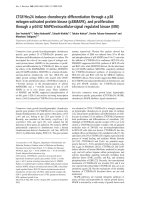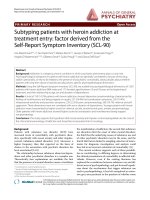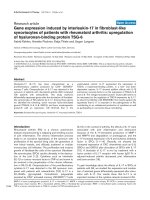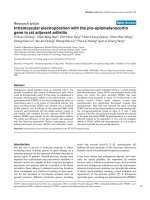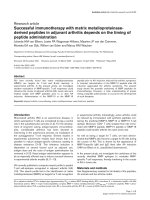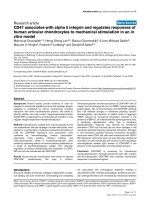Báo cáo y học: " Helping someone with problem drug use: a delphi consensus study of consumers, carers, and clinicians" pptx
Bạn đang xem bản rút gọn của tài liệu. Xem và tải ngay bản đầy đủ của tài liệu tại đây (329.38 KB, 7 trang )
RESEARC H ARTIC LE Open Access
Helping someone with problem drug use: a
delphi consensus study of consumers, carers,
and clinicians
Anna H Kingston
1
, Amy J Morgan
1
, Anthony F Jorm
1
, Kate Hall
1
, Laura M Hart
1
, Claire M Kelly
1
, Dan I Lubman
1,2*
Abstract
Background: Problem use of illicit drugs (i.e. drug abuse or dependence) is associated with considerable health
and social harms, highlighting the need for early intervention and engagement with health services. Family
members, friends and colleagues play an important role in supporting and assisting individuals with problem drug
use to seek professional help, however there are conflicting views about how and when such support should be
offered. This paper reports on the development of mental health first aid guidelines for problem drug use in
adults, to help inform community members on how to assist someone developing problem drug use or
experiencing a drug-related crisis.
Methods: A systematic revi ew of the scientific and lay literature was conducted to develop a 228-item survey
containing potential first-aid strategies to help someone developing a drug problem or experiencing a drug-
related crisis. Three panels of experts (29 consumers, 31 carers and 27 clinicians) were recruited from Australia,
Canada, New Zealand, the United Kingdom, and the United States. Panel members independently rated the items
over three rounds, with strategies reaching consensus on importance written into the guidelines.
Results: The overall response rate across three rounds was 80% (86% consumers, 81% carers, 74% clinicians). 140
first aid strategies were endorsed as essential or important by 80% or more of panel members. The endorsed
strategies provide information and advice on what is prob lem drug use and its consequences, how to approach a
person about their problem drug use, tips for effective communication, what to do if the person is unwilling to
change their drug use, what to do if the person does (or does not) want professional help, what are drug-affected
states and how to deal with them, how to deal with adverse reactions leading to a medical emergency, and what
to do if the person is aggressive.
Conclusions: The guidelines provide a consensus-based resource for community members who want to help
someone with a drug problem. It is hoped that the guidelines will lead to better support and understanding for
those with problem drug use and facilitate engagement with professional help.
Background
The Mental Health First Aid (MHFA) program is an
educational course designed to teach members of the
public skills in recognizing and responding to mental
disorders in another person [1]. MHFA is modelled on
physical first aid, and is the early help provided to some-
one developing a mental disorder, as well as assistance
during mental health crisis situations. The MHFA
program teaches first aid for a variety o f mental health
problems, including depression, anxiety, trauma, psycho-
sis, eating disorders and suicidal behaviour. The pro-
gram was developed in response to the often poor
mental health literacy of members of the public, who
may lack knowledge about mental disorders and how
they can best be treated, The MHFA progra m has sepa-
rate versions for adults and adults assisting youth, and
has been adapted for Indigenous Australians and some
non-English speakin g immigrant groups. Controlled
trials have shown that the program improves recogni-
tion of mental disorders, beliefs about treatments, and
* Correspondence:
1
Orygen Youth Health Research Centre, Centre for Youth Mental Health,
University of Melbourne, Victoria, Australia
Full list of author information is available at the end of the article
Kingston et al. BMC Psychiatry 2011, 11:3
/>© 2011 Kingston et al; licensee BioMed Central Ltd. This is an Open Access article distributed under the terms of the Creative
Commons Attribut ion License (http://c reativecommons.org/licenses/by/2.0), which permits unrestricted use, distribution, and
reproduction in any medium, provided the original work is properly cited.
helping behaviour provided, as well as reducing social
distance [2]. More than 100,000 people have co mpleted
a MHFA course in Australia and the course has spread
to 14 other countries.
The MHFA program also teaches participants how to
assist a person who has problem use of illicit drugs.
Within the program , first aid for problem drug use is
defined as the help provided to a person developing a
drug use problem or experiencing a drug-related crisis
(e.g. overdose, drug-induced psychosis). The first aid is
given until appropriate professional treatment is
received or until the crisis resolves. Drug use disorders
are associated with substantial morbidity and mortality,
with significant impacts evident on the user, their
family, and the broader community. Despite such
harms, many individuals with drug use disorders do not
seek treatment, with delays in accessing professional
help often for a decade or more [3,4]. Nevertheless,
community members and concerned others (family,
friends, colleagues) have an important role in supporting
and a ssisting a person with a drug use disorder to seek
treatment or change their behaviour [5]. However, there
are conflicting views about how to support a person
with illicit drug problems, with some people believing
that a person cannot be helped until they have ‘hit bot-
tom’, (i.e. their drug use causes overwhelming problems
in multiple areas of their life) [6]. The MHFA program
can thus give members of the public confidence in pro-
viding support and assistance to someone who is devel-
oping a drug use problem.
To increase the e vidence base of MHFA, guidelines
for mental health first aid strategies have been devel-
oped using expert consensus (the Delphi method). Evi-
dence from expert consensus is particularly suited for
this t ype of intervention, as it is not feasible to use the
gold-standard randomised controlled trial to investigate
the effectiveness of different first aid strategies for devel-
oping mental disorders. Consensus from co nsumers and
carers in addition to consensus from clinicians is impor-
tant because consumers and carers have different per-
spectives and types of experience to draw on, and they
represent people who might typica lly receive or give
first aid. Guidelines have been developed for a number
of developing mental health problems and crises [7-13],
including problem alcohol use [14].
This paper reports on the development of mental
health first aid guidelines for problem drug use in
adults. We d efined problem drug use as using cannabis,
ecstasy, amphetamines (including methamphetamine),
cocaine or heroin, at levels that are associated with both
short- and long-term harm. Problem drug use therefore
includes drug-affected states, drug abuse and drug
dependence. The aim was to get consensus between
experts on the best way a member of the public could
help someone who was developing problem drug use, or
who was experiencing a drug-related cri sis. Once estab-
lished, these guidelines would inform an update of the
MHFA training program, and would empower members
of the public to provide crucial and appropriate support
to family, friends or loved ones experiencing or develop-
ing a drug use problem.
Methods
The Delphi Method
The Delphi method involves a panel of experts making
private, independent ratings of agreement with a series
of statements [15]. Statements about ment al health first
aid strategies for problem drug use were derived from a
search of the lay and scientific literature, and these were
presented to a panel of experts in three sequential
rounds. New strategies suggested by panel members
were included as statements in the secon d round for all
experts to rate. A summary of group ratings was f ed
back to the panel members after the first and second
rounds. Panel members could choose to either change
or maintain their original ratings, in light of the group
ratings. This process resulted in a list of statements that
had substantial consensus in ratings, and statements
with low or conflicting ratings were discarded.
Panel formation
Consumers, carers and clinicians from Australia, Canada,
New Zealand, the Unite d Ki ngdom and the United States
were recruited into three separate panels, all with exper-
tise in problem drug use. Consumers (people with a past
history of problem drug use) and carers (people with
experience caring for someone with problem drug use)
were recruited by distributing i nformation about the
study to consumer and carer organizations associated
with substance use or mental health issues in each coun-
try. We specified that an y cons umers and carers who
took part needed to be in an advocacy role, which we
define d as havi ng represented the interest s of drug users
or their carers within the community. This was to ensure
that participants had an u nderstanding of problem use
bey ond th eir pe rsonal experie nce. Consumers and carers
were offered a bookshop voucher worth AUD 33 for each
round of the survey they completed. More than 300 clini-
cal experts were initially invited to participate, sourced
from the editorial boards of 8 leading peer-reviewed sub-
stance use journals, addiction specialist colleges and
societies, or experienced clin icians working within alco-
hol and other drug settings. A strength of the Delphi
method is that it does not require representative sam-
pling; it requires panel members who are information-
and experience-rich.
Eighty-seven panel members from Australia, Canada,
New Zealand, the United Kingdom and the United
Kingston et al. BMC Psychiatry 2011, 11:3
/>Page 2 of 7
States were recruited. There were 29 consumers,
31 carers, and 27 clinicians. Fifty-one panel members
were female (59% of the consumers, 74% carers, 33% of
the clinicians). The median age category was 40-49
years f or the consumers, 50-59 years for the carers and
50-59 years for the clinicians. Out of the 27 clinicians
on the panel, there were 8 psychologists, 5 psychiatrists,
3 medical specialists, 1 p harmacist, 1 psychopharmacol-
ogist, 1 registered nurse, 1 dual diagnosis clinician,
1 ACT (Acceptance and Commitment Therapy) thera-
pist, 5 professors, 1 research fellow, 6 researchers,
1 consultant, and 1 director of a specialist centre (figures
do not add up to 27 as clinicians reported multiple roles).
Questionnaire development and administration
A systematic lit erature review was conducted of web-
sites, books and journal articles for strategies about how
to help someone who may be developing or experien-
cing a drug use problem. This involved a comprehensive
Internet search in google search engines [16-18]. The
following search terms were entered into each: cannabis
or ecstasy or amphetamine or cocaine or opioids.The
first 50 sites for each set of search terms were examined
for statements about how to help someone who may
have a drug use problem. Any links that appeared on
these web pages that the authors thought may contain
useful information were followed. Relevant journal arti-
cles were located on PsycINFO and PubMed. The
50 most popular books on the Amazon website were
also selected and reviewed. We obtained suggestions for
first aid strategies from approximately 18 websites,
7 books, 1 pamphlet and 2 journal articles. The majority
of first aid strategies came from websites, as few books
and journal articles focused on pre-clinical interventions.
In addition, the questionnaire content was informed by
a questionnaire previously developed to create first aid
guidelines for problem drinking [14], as well as strate-
gies suggested by the working group to fill perceived
gaps in the questionnaire’s content.
The information gathered from these sources was ana-
lysed by one of the authors (AK) and written up as indivi-
dual survey items. This document was presented to a
working group, who screened the i tems to ensure they
fitted the definition of first aid for problem drug use,
were c omprehensible, and had a consistent format, while
remaining as faithful as possible to the original wording
of the information. After several draft surveys, the gr oup
produced a list of 228 items thatformedthefirstsurvey
sent to panel members. The Round 1 survey was orga-
nized into 13 sections (see Table 1). Panel members were
asked to rate the importance of each item as a first aid
strategy, bearing in mind that a first ai der was a member
of the g eneral public and therefore did not necessarily
have a medic al or clinical backgroun d. The ratin g scal e
used was essential, important, depends, unimportant,
should not be included, don’t know. The Round 1 survey
also included co mment boxes tha t allowed pa nel mem-
bers to give feedback after each section. To analyse the
comments that panel members had written in the first
round questionnaire, one of the authors (AK) read
through all the comments and wrote them up as draft
first aid strategies. The working group evaluated the sug-
gested draft strategies to determine whether they were
originalideasthathadnotbeenincludedinthefirst
round questionnaire. Any strategy that was judged by the
group to be an original idea wa s included as a new item
to be rated in the second round questionnaire.
Panel members completed the questionnaires online
(using SurveyMonkey [19]). The study was approved by
the Human Research Ethics Committee at the University
of Melbourne.
Statistical analysis
On completion of each round, the survey responses
were analysed by obtaining percentages for the consu-
mer, carer and clinician panels for each item. The fol-
lowing cut-off points were used:
Criteria for accepting an item
• If at least 80% of the consumer, carer and clinician
panels rated an item as essential or important as a first
aid guideline for problem drug use, it was included in
the guidelines.
Criteria for re-rating an item
• If 80% or more of the panel members in one group
rated an item as essential or important as a first aid
guideline for problem drug use, we asked all panel
members to rerate that item in the next round.
Table 1 Round 1 survey sections and number of items
Section Number of
items
Understanding problem drug use 13
Recognising problem drug use 7
Approaching the person about their problem drug use 68
Information and support for the person who wants to
stop using drugs
6
Professional help 25
What to do if the person is unwilling to change their
drug use
15
Understanding drug-affected states 7
Interacting with, and responding to, the drug-affected
person
7
Maintaining the drug-affected person’s safety 9
General principles for recognising and responding to
adverse reactions
9
Responding to particular adverse reactions 15
Responding to medical emergencies 15
What to do if the person is agitated or aggressive 32
Kingston et al. BMC Psychiatry 2011, 11:3
/>Page 3 of 7
• If 70-79% of panel members from all three g roups
rated an item as essential or important, we asked all
panel members to rerate that item.
• Items were re-rated o nce only. If an item was not
endorsed after two rounds it was excluded from the
guidelines.
Criteria for rejecting an item
• Any items that did not meet the above conditions
were excluded.
Results
See Figure 1 for an overview o f the numbers of items
that were included, excluded, created and re-rated in
each round of the survey. The response rate of those
who took part in all three rounds was 80% (86% consu-
mers, 81% carers, 74% clinicians). See Table 2 for the
number of panel members who completed each round.
ParticipantfeedbackfromtheRound1questionnaire
indicated there was confusion about the difference
between physical first aid and mental health first aid. In
addition, it appeared that the panel members assumed
that the items in the Round 1 questionnaire were
targeting people with entrenched drug disorders, rather
than those who were developing drug use problems. To
address these concerns, the Round 2 questionnaire
clearly stated t he distinction between phy sical first aid
and mental health first aid. In addition, a new section
was added called ‘Developing a drug u se problem’.In
this section, all items from the Round 1 questionnaire
sections about ‘appro aching the person’, ‘information
andsupportforstoppingorreducingdruguse’ and
‘professional help’ were resubmitted to the panel. These
sections were prefaced with the statement, “these items
are about helping a person who is just starting to
develop problems as a result of their drug use.” Thus, a
251-item survey was developed for Round 2. It com-
prised the 74 new items suggested by pa nel members,
the 65 items from round 1 to be re-rated in Round 2,
and 112 items in the ‘Developing a drug use problem’
section. However , analys is showed that presenting items
from the Round 1 questionnaire in the new section
‘Developing a drug use problem’ made little difference
to which items were endorsed. Consequently, the sec-
tion on ‘Developing a drug use problem’ was not sub-
mitted for re-rating in Round 3, nor was the distinction
between ‘entrench ed’ and ‘ develo ping’ drug use pro-
blems included in the guidelines.
Across the three ro unds, 140 strategies were rated as
essential or important by ≥80% of the panel members
(see Additional File 1: Items that received 80% c onsen-
sus across both t he consumer, carer and c linician
pan els). Overall, ratings of whether items were essential
or important were similar across the consumer, clini-
cian, and carer panels, with correlations of r = 0.89
between consumers and carers, r = 0.88 between consu-
mers and clinicians, and r = 0.89 between and clinicians
and carers. One of the authors (AK) prepared the final
guidelines by grouping items of similar c ontent under
specific headings. The items were strung together into
prose so that the guidelines offered the first a ider a
coherent approach to first aid for problem drug use.
The guidelines retained theoriginalwordingofthe
items as much as p ossible, whilst remaining easy-to-
read. F urthermore, some items were given examples to
clarify the general nature of the advice, for instance,
including some examples of consequences of problem
Round1
questionnaire
(228items)
Itemstobe
included(n=70)
Itemstobe
excluded(n=93)
Itemstobe
reͲrated(n=65)
Newdraftitems
(n=74)
Round2
questionnaire
(251items)
Developingadrug
useproblem
items(n=112)
Itemstobe
included(n=66)
Itemstobe
excluded(n=
166)
ItemstobereͲ
rated(n=19)
Round3
questionnaire(19
items)
Itemstobe
included(n=4)
Itemstobe
excluded(n=15)
Totalincluded
items(n=140)
Figure 1 Overview of items included, excluded, created and re-
rated in each round of the survey.
Table 2 Participant numbers for each round of the
survey
Round 1
n
Round 2
n (%)
Round 3
n (%)
Consumer 29 26 (90%) 25 (86%)
Carers 31 25 (81%) 25 (81%)
Clinicians 27 23 (85%) 20 (74%)
Total 87 74 (85%) 70 (80%)
Kingston et al. BMC Psychiatry 2011, 11:3
/>Page 4 of 7
drug use. Additional items about ‘what to do if the per-
son is aggressive’ were incl uded in these guidelines.
These items were taken from the first aid guidelines for
problem drinking, which were developed using the same
Delphi process use d to devel op the current guidelines
[14]. The guidelines were then given to panel members
for final comment, feedback and endorsement. Any
comments made by panel members were presented to
the working group and integrated into the document if
they made the text clearer. However, new content was
not accepted at this stage.
The final guidelines (see Additional File 2) provide
information and advice on what is problem drug use
and its consequences, how to approach the person
about t heir problem drug use, tips for ef fective commu-
nicatio n, what to do if the person is unwilling to change
their drug use, what to do if the person do es (or d oes
not) want professional help, what are drug-affected
states and how to deal with them, how to deal with
adverse reactions leading to a medical emergency, and
what to do if the person is aggressive.
Discussion
This research aimed to identify first aid strategies that
members of the public co uld carry out to assist some-
one developing problem drug use or experiencing drug-
related crises. We have show n that it is possible for
experts to reach consensus on first aid for problem drug
use that can be applied across several types of illicit
drugs. Over one-hundred first aid strategies were
endorsed from a comprehensive range of first aid sug-
gestions. The endorsed strategies were written into a
cohesive guideline document. This is currently the only
resource that provides consensus on mental health first
aid strategies for problem drug use between expert clini-
cians, carers, and consumers.
Although one of the aims of the study was to pro-
vide guidance on how community members could
facilitate help seeking for problem drug users, there
was generally low endorsement of directive methods or
encouragement for them to seek help. For example,
the strategies The first aider should suggest the person
attends a support group, The first aider should offer to
make an appointment,andThe first aider should enlist
the help of others (such as a doctor, relative or friend)
to conf ront the person as a group, were all outright
rejected in the first round of the survey. Rejection of
thelastitemisconsistentwiththeresearchevidence
on confrontational approaches (e.g. Johnson Interven-
tion)[20], which highlights a low success rate in enga-
ging the person with treatment services, as well as
increasing the risk of long-lasting distress as a result of
the perceived betrayal and secrecy involved in their
organization [6].
Rather, the guidelines indicate that the general approach
the first aider should take is to remain supportive and
approachable, support the person in seeking help or chan-
ging their behaviour if that is their wish, but not be overly
forceful or impinge on their autonomy. P anel members
wrote, “pushing ‘seeking help’ may interfere with the rela-
tionship and cause the drug user stress, which could
exacerbate the drug taking“ and “you can lead a horse to
water but you can’t make them drink you can’tforcea
person to seek professional help, as they will probably con-
tinue to use more sec retively, which can cau se more harm
to themselves“. The endorsement that it is the drug user’s
decision to seek help, a nd first aiders should not force
them to, is consistent with mental health first aid guide-
lines for other problems (e.g. problem drinking, suicidal
thoughts a nd behaviours). These acknowledge that the
role of the first aider is only to support and assist the per-
son if they want to seek help, subject to particular caveats.
However, the guidelines acknowledge the difficulty first
aiders face in maintaining a good relationship with the
person while accepting that they cannot make the person
change if they do not want to reduce or cease their pro-
blem drug use. One endorsed exception to ensuring the
person’s au tonomy was permission for first aiders to dis-
close the person’s drug u se to a professional when they
were at risk of harming others.
Some family members or partners engage in enabling
behaviours that potentially reinforce the person’s
ongoing drug use. These behaviours include specific
types of caretaking (e.g. taking over childcare or paying
living expenses) and attempts to stabilise external situa-
tions caused or exacerbated by drug use (e.g. making
excuses or lying to others to protect the drug user)
[21,22]. These occur as a way of coping with the drug
abuse when the person refuses to change their beha-
viour or seek help. Enabling behaviours are assumed to
be maladaptive and are often a target for clinical inter-
ventions. Panel members were generally cons iste nt with
this view of enabling, with endorsement of most of the
items that discouraged enabling behaviours. The strategy
The first aider should not take on the person’sresponsi-
bilities was endorsed by all three panels in Round 1, and
the strategies The first aider should not use drugs with
the person and Th e first a ider should not cover up or
make excuses for the person were accepted in Round 2
after re-rating. However, The first aider should not pro-
vide the person with mo ney to buy d rugs and The first
aider should never get involved w ith helping the person
acquire drugs, e.g. driving the person to meet the dealer
were not endorsed as first aid strategies. Strategies that
took a h arder line o n discouraging enabl ing were less
likely to b e endorsed. For example, the strategies The
first aider should deny the person basic needs, such as
keeping them warm, clean and nourished ,andThe first
Kingston et al. BMC Psychiatry 2011, 11:3
/>Page 5 of 7
aider should hide or throw out the person’ sdrugswere
only endorsed by about 3% of panel members.
The study involved an international sample of experts
in problem drug use. These were selected as ‘informa-
tion-rich’ sources of expertise. However, it was apparent
after the first round of the questionnaire that panel
memb ers found it hard to relate to the concept of help-
ing s omeone wit h a developing, rather than just an
entrenched, drug use problem, and in situations beyond
the more familiar physical health crises requiring physi-
cal first aid. Therefore, although a departure from the
usual Delphi approach, it was decided to resubmit some
strategies to the panel to rate. We emphasized more
clearly that the strategies were for developing disorders,
as well as entrenched drug problems, in order to make
sure that strategies were not being rejected because
panel members found them inappropriate for those with
entrenched drug disorders alone. However, as noted
above, panel members did not si gnificantly change their
ratings, indicating that first aid recommendations do not
differ depending on the stage of problem drug use.
The guidelines were developed specifically for Western,
English speaking countries and may have limited applic-
ability to other countries. They also may not be applic-
able to cultural minorities within English-speaking
countries. However, other mental health first aid guide-
lines have been adapted for other c ultures (e.g. Problem
drinking for Australian Aboriginal and Torres Strait
Islander Peoples [23]) so adaptations for other c ultures
are possible. The guidelines were designed to inform the
content of MHFA training programs, and have been used
in the development of an improved second edition of the
MHFA training course [24,25]. Although p revio us tria ls
have found MHFA training effective in improving knowl-
edge, reducing stigma and increasing helping behaviour
[1], studies of the updated training course are required to
ensure its effectiveness and that there are not unintended
harms, such as labelling people in a way that might
increase stigma and marginalization. The use of the
guidelines as a stand-alone document is also yet to be
tested, but research is currently underway to investigate
whether people who download the guidelines from the
MHFA website find them useful in providing first aid.
Conclusions
In conclusion, these guidelines provide best practice
mental health first aid strategies for problem use of can-
nabis, ecstasy, amphetamines, cocaine or heroin. The
guidelines will provide an important resource for mem-
bers of the public seeking to help someone with pro-
blem drug use. It is hoped that the guidelines will lead
to better suppo rt for thos e with problem drug use and
will facilitate earlier intervention. Future research should
assess the effectiveness of the first aid strategies
endorsed within these guidelines to ensure that they
increase supportive behaviour and help during crisis
situations.
Additional material
Additional file 1: Items that received 80% consensus across the
consumer, carer and clinician panels.
Additional file 2: Helping someone with problem drug use: Mental
Health First Aid guidelines. This file may be distributed freely, with the
authorship and copyright details intact. Please do not alter the text or
remove the authorship and copyright details.
Acknowledgements
Funding was provided by the Melbourne Research Grants Scheme, the
Australian Government Department of Health and Ageing and the Colonial
Foundation. Professor Anthony Jorm is an NHMRC Fellow (Fellowship No.
400001). None of the funding sources had any further role in study design;
in the collection, analysis and interpretation of data; in the writing of the
report; or in the decision to submit the paper for publication. The authors
gratefully acknowledge the time and effort of the panel members, Leanne
Hides for her contribution to the reference group and Zoe Shearer for
assisting with the administration of the study.
Author details
1
Orygen Youth Health Research Centre, Centre for Youth Mental Health,
University of Melbourne, Victoria, Australia.
2
Turning Point Alcohol and Drug
Centre, Eastern Health and Monash University, Victoria, Australia.
Authors’ contributions
AJ and DL designed the study and wrote the protocol with input from KH,
CK and AK. AK completed the literature review, initial survey construction,
recruitment of participants, data collection and analysis, and prepared drafts
of the guidelines. A working group, consisting of AJ, DL, AK, KH, CK and LH,
gathered regularly to give feedback and make improvements on each draft
of the Rounds 1, 2 and 3 surveys and the final guidelines. AM wrote the first
draft of the manuscript with input from AJ, AK and DL. All authors have
contributed to and approved the final manuscript.
Competing interests
Anthony Jorm is research director of MHFA and Claire Kelly is co-ordinator
of Youth MHFA.
Received: 3 June 2010 Accepted: 5 January 2011
Published: 5 January 2011
References
1. Kitchener BA, Jorm AF: Mental Health First Aid: an international
programme for early intervention. Early Interv Psychiatry 2008, 2 :55-61.
2. Kitchener BA, Jorm AF: Mental health first aid training: review of
evaluation studies. Aust N Z J Psychiatry 2006, 40:6-8.
3. Kessler RC, Aguilar-Gaxiola S, Berglund PA, Caraveo-Anduaga JJ, DeWit DJ,
Greenfield SF, Kolody B, Olfson M, Vega WA: Patterns and predictors of
treatment seeking after onset of a substance use disorder. Arch Gen
Psychiatry 2001, 58:1065-1071.
4. Wang PS, Angermeyer M, Borges G, Bruffaerts R, Chiu WT, de Girolamo G,
Fayyad J, Gureje O, Haro JM, Huang YQ, et al: Delay and failure in
treatment seeking after first onset of mental disorders in the World
Health Organization’s World Mental Health Survey Initiative. World
Psychiatry 2007, 6:177-185.
5. Fernandez AC, Begley EA, Marlatt GA: Family and peer interventions for
adults: past approaches and future directions. Psychol Addict Behav 2006,
20:207-213.
6. Stanton MD: Getting reluctant substance abusers to engage in
treatment/self-help: a review of outcomes and clinical options. J Marital
Fam Ther 2004, 30:165-182.
Kingston et al. BMC Psychiatry 2011, 11:3
/>Page 6 of 7
7. Hart LM, Jorm AF, Paxton SJ, Kelly CM, Kitchener BA: First aid for eating
disorders. Eat Disord 2009, 17:357-384.
8. Kelly C, Jorm A, Kitchener B: Development of mental health first aid
guidelines for panic attacks: a Delphi study. BMC Psychiatry 2009, 9:49.
9. Kelly CM, Jorm AF, Kitchener BA: Development of mental health first aid
guidelines on how a member of the public can support a person
affected by a traumatic event: a Delphi study. BMC Psychiatry 2010, 10:49.
10. Kelly CM, Jorm AF, Kitchener BA, Langlands RL: Development of mental
health first aid guidelines for deliberate non-suicidal self-injury: a Delphi
study. BMC Psychiatry 2008, 8:1-10.
11. Kelly CM, Jorm AF, Kitchener BA, Langlands RL: Development of mental
health first aid guidelines for suicidal ideation and behaviour: a Delphi
study. BMC Psychiatry 2008, 8:1-10.
12. Langlands RL, Jorm AF, Kelly CM, Kitchener BA: First aid for depression: a
Delphi consensus study with consumers, carers and clinicians. J Affect
Disord 2008, 105:157-165.
13. Langlands RL, Jorm AF, Kelly CM, Kitchener BA: First aid recommendations
for psychosis: using the Delphi method to gain consensus between
mental health consumers, carers, and clinicians. Schizophr Bull 2008,
34:435-443.
14. Kingston AH, Jorm AF, Kitchener BA, Hides L, Kelly CM, Morgan AJ, Hart LM,
Lubman DI: Helping someone with problem drinking: Mental health first
aid guidelines - a Delphi expert consensus study. BMC Psychiatry 2009,
9:79.
15. Jones J, Hunter D: Qualitative research: consensus methods for medical
and health services research. BMJ 1995, 311:376-380.
16. Google. [].
17. Google Australia. [].
18. Google UK. [].
19. SurveyMonkey. [ />20. Johnson VE: Intervention: How to Help Someone who Doesn’t Want Help
Minneapolis, MN: Johnson Institute Books; 1986.
21. Rotunda RJ, Doman K: Partner enabling of substance use disorders:
critical review and future directions. Am J Fam Ther 2001, 29:257-270.
22. Rotunda RJ, West L, O’Farrell TJ: Enabling behavior in a clinical sample of
alcohol-dependent clients and their partners. J Subst Abuse Treat 2004,
26:269-276.
23. Aboriginal Mental Health First Aid Training and Research Program: Problem
Drinking: Guidelines for providing Mental Health First Aid to an Aboriginal or
Torres Strait Islander Person Melbourne: Orygen Youth Health Research
Centre, University of Melbourne and beyondblue: the national depression
initiative; 2009.
24. Kelly CM, Kitchener BA, Jorm AF: Youth Mental Health First Aid: A Manual for
Adults Assisting Young People (Second edition) Melbourne: Orygen Youth
Health Research Centre; 2010.
25. Kitchener BA, Jorm AF, Kelly CM: Mental Health First Aid Manual (Second
edition) Melbourne: Orygen Youth Health Research Centre; 2010.
Pre-publication history
The pre-publication history for this paper can be accessed here:
/>doi:10.1186/1471-244X-11-3
Cite this article as: Kingston et al.: Helping someone with problem drug
use: a delphi consensus study of consumers, carers, and clinicians. BMC
Psychiatry 2011 11:3.
Submit your next manuscript to BioMed Central
and take full advantage of:
• Convenient online submission
• Thorough peer review
• No space constraints or color figure charges
• Immediate publication on acceptance
• Inclusion in PubMed, CAS, Scopus and Google Scholar
• Research which is freely available for redistribution
Submit your manuscript at
www.biomedcentral.com/submit
Kingston et al. BMC Psychiatry 2011, 11:3
/>Page 7 of 7
